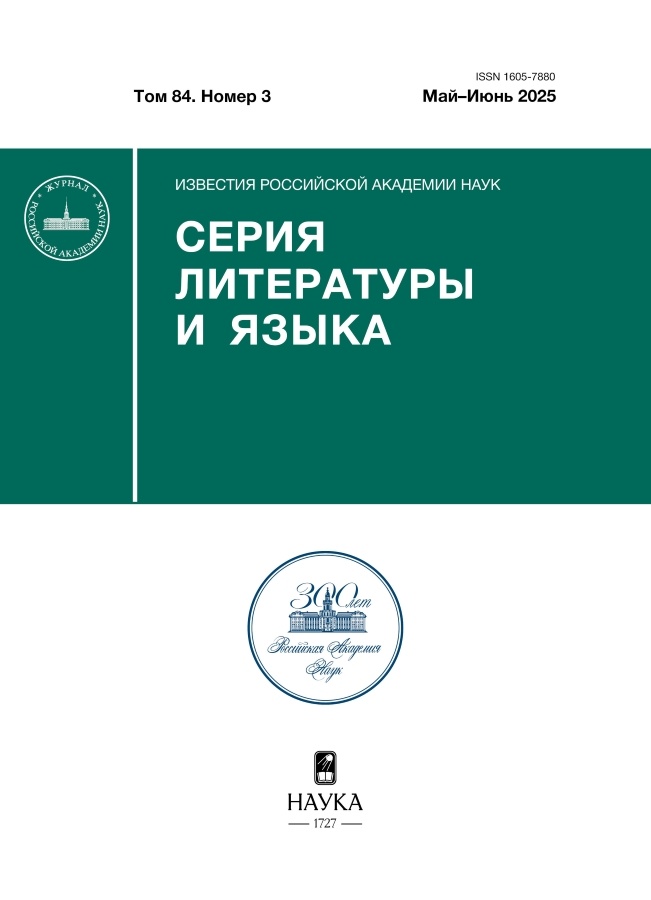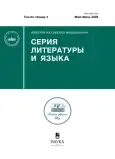Полиметрический стих Генриха Сапгира (на примере цикла «Мемуары с ангелами в Красково»)
- Авторы: Азаренков А.А.1
-
Учреждения:
- Национальный исследовательский университет «Высшая школа экономики»
- Выпуск: Том 84, № 3 (2025)
- Страницы: 37-48
- Раздел: Статьи
- URL: https://gynecology.orscience.ru/1605-7880/article/view/691875
- DOI: https://doi.org/10.31857/S1605788025030046
- ID: 691875
Цитировать
Полный текст
Аннотация
В статье анализируется полиметрический стих поэтического цикла Генриха Сапгира «Мемуары с ангелами в Красково». Статья состоит из пяти разделов. В первом разделе идет речь о метрической гетероморфности сапгировского стиха. Делается вывод, что при создании полиметрии Сапгир пользуется не столько метрами, сколько размерами, входящими в его метрический репертуар как «готовые» формы. Второй раздел посвящен тонической структуре «Мемуаров…», во многом обусловленной повторением одних и тех же разновидностей дольника. В третьем разделе говорится о свободном стихе, в малой мере присутствующем в сапгировском цикле. В четвертом разделе наводится общая статистика по метрам и анализируются способы их сочетаний. В пятом разделе рассматриваются фонические эффекты стиха «Мемуаров…», связанные с его полиморфной природой. Сапгир существенно расширяет возможности русского метрического стихосложения, вырабатывая особый тип полиметрии, оперирующей устойчивыми сочетаниями метров, вкраплениями тонического и свободного стиха, а также выразительными возможностями сверхкороткой строки. Важную роль в формировании стиха Сапгира играет графика текста, разбитого на синтагмы и отдельные слова, что приводит к возникновению вторичного ритма – ритма стихоразделов и звуковых повторов. Таким образом, один и тот же текст в зависимости от способа чтения может восприниматься и как метрический, и как тонический, и как свободный. Предложенная Сапгиром модель полиметрии представляет собой переходную форму стиха, постоянно отрицающего свою регулярность, но при этом функционирующего по вполне определенным законам. Такой стих может быть рассмотрен как современный этап эволюции русского метрического стихосложения.
Об авторах
А. А. Азаренков
Национальный исследовательский университет «Высшая школа экономики»
Email: aazarenkov@hse.ru
Москва, ул. Старая Басманная, д. 21/4
Список литературы
- Сапгир Г.В. Собрание сочинений: В 4 т. М.: Новое литературное обозрение, 2024.
- Кукулин И.В. Реабилитация воображения: как читать Генриха Сапгира после концептуализма? // Восемь великих: коллективная монография. М.: РГГУ, 2022. С. 389–397.
- Орлицкий Ю.Б. Стихосложение новейшей русской поэзии. М.: Издательский Дом ЯСК, 2020. 1016 с.
- Бельская Л.Л. О полиметрии и полиморфности (на материале поэзии С. Есенина) // Проблемы теории стиха. Л.: Наука, 1984. С. 99–109.
- Гаспаров М.Л. Очерк истории русского стиха. Метрика. Ритмика. Рифма. Строфика. М.: Фортуна Лимитед, 2000. 352 с.
- Холшевников В.Е. Мысль, вооруженная рифмами. Поэтическая антология по истории русского стиха. Л.: ЛГУ, 1987. 606 с.
- Орлицкий Ю.Б. Стих и проза в русской литературе. М.: РГГУ, 2002. 685 с.
- Корчагин К.М. Русский стих: цезура. СПб.: Алетейя, 2021. 520 с.
- Гаспаров М.Л. Русский стих начала XX века в комментариях. М.: Фортуна Лимитед, 2001. 288 с.
- Корчагин К.М. Гетерометрия и полиметрия Велимира Хлебникова // Язык как медиатор между знанием и искусством. М.: Азбуковник, 2009. С. 147–160.
- Плунгян В.А. Мне с каждым утром противней заученный, мертвый стих: к некоторым особенностям тонического стиха М. Кузмина // The Many Facets of Mikhail Kuzmin: A Miscellany. Bloomington (IN): Slavica, 2011. С. 43–57.
- Гаспаров М.Л. Русский трехударный дольник XX в. // Теория стиха. Л.: Наука, 1968. С. 59–106.
- Пильщиков И.А. «По ту сторону дольника»: Безударные икты и сверхсхемные ударения в русском акцентном стихе // Критика и семиотика. 2022. № 1. С. 273–318.
- Шапир М.И. Исчисление силлабо-тонической парадигмы (случай Сумарокова: «Цефал и Прокрис») // Universum versus: Язык – стих – смысл в русской поэзии XVIII–XX веков. Кн. 1. М.: ЯРК, 2000. С. 187–191.
- Шварц Е.А. Сочинения Елены Шварц: В 5 т. СПб.: Пушкинский фонд, 2002–2013.
- Шерр Б.П. Микрополиметрия Елены Шварц // Славянский стих, IX. М.: Рукописные памятники древней Руси, 2012. С. 105–116.
- Корчагин К.М. Еще раз о раннем русском свободном стихе // Корпусный анализ русского стиха. М.: Азбуковник, 2013. С. 219–242.
- Левашов А.М. Статистический анализ метрической структуры русского верлибра // Труды Института русского языка им. В.В. Виноградова. 2022. № 4 (34). С. 78–85.
Дополнительные файлы








